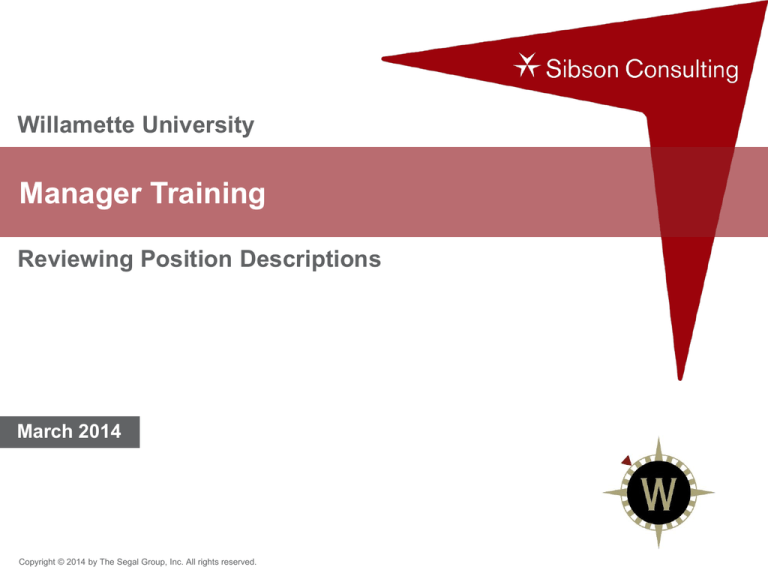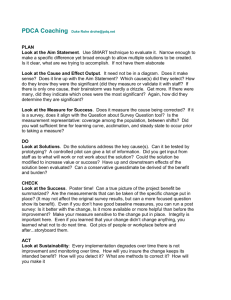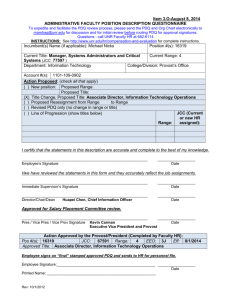
Willamette University
Manager Training
Reviewing Position Descriptions
March 2014
Copyright © 2014 by The Segal Group, Inc. All rights reserved.
Willamette Compensation/Classification Program Study
Classification structure
Reporting relationships
Job levels/families
Job/work design
Titles
Institutional
Strategy
Mission, Vision, and
Strategic Goals of
the institution
Compensation
Philosophy
Vision statement
Program model
Internal/External
Value
Comparison
Markets
Link to performance
Communication
Governance
Job
Structure
Job Analysis
and Evaluation
Integrated
Compensation
Program
Pay
Delivery
Pay progression
Pay opportunity
linked to level
Variable or incentive
pay
Pay administration
Salary
Structure
Salary levels, bands,
and ranges
Control mechanisms
Link to the market
Structure movement
Job documentation
Evaluation factors
Internal versus external
emphasis
Evaluation process
Outcomes
Strategic compensation
program to attract/retain
qualified staff
Foundation for other
human capital initiatives
Credible within internal
community
Understandable by
leadership,
administrators, and staff
2
Project Timeline (Planned)
Phase
Fall
2013
Jan
Feb
Mar
Apr
May
Jun
Jul
Aug
+
Phase A – Project Planning
and Philosophy/Strategy
Development
Phase B – Job Analysis
and Design
X
Phase C - Competitive
Market Assessment
Phase D – Salary
Structure, Job Leveling
Methodology and Pay
Guidelines Development
Phase E – Implementation
Plan Defined
3
Today’s Objectives
1
Review the PDQ process and your role in the process
2
Provide guidance on how to review a position description
4
Position Description Questionnaire
Roles in completing PDQs
Individual Employees are responsible for
ensuring that:
PDQs are complete and submitted on
time
Reference documents (e.g., job
descriptions) are utilized when available
to ensure completeness of PDQs
Supervisors are responsible for:
Ensuring all PDQs within their
department have been completed and
are accurate
Signing off on completed questionnaires
of their direct reports
Ensuring that employee and manager
have consensus on the final PDQ
Human Resources will be responsible for
ensuring that:
PDQs have been reviewed and
discrepancies have been addressed
PDQs are consolidated for different
employees in the same jobs
ILLUSTRATIVE EXAMPLE
Supervisor:
Susan
Individual
Employee:
Steve
Individual
Employee:
Bob
Title:
Coordinator,
Benefits
Title:
Coordinator,
HR Data
Steve, Bob, and Emily complete
their own PDQs (soliciting supervisor
input during completion), then Susan
reviews and approves all three
position descriptions.
Individual
Employee:
Emily
Title: Staff
Assistant, HR
Human Resources uses the consolidated
PDQS to ensure job descriptions are
current and accurate.
5
How to Review Position Descriptions
1. Review each element of the position description for accuracy
Position Descriptions should describe the position, not the person
Position Descriptions should describe and answer questions regarding the position based on
the current position, not anticipated, temporary, or outdated functions
Position Titles should be used when referring to others at Willamette
2. Spell-out acronyms and clarify technical jargon
Please make changes directly in the body of the position description
3. Ensure the position description is complete
Please add any missing information in the position description
It is important that all sections be reviewed, but the job summary and primary job
responsibilities sections are the most critical sections
6
How to Review Position Descriptions continued
4. Highlight any unique tasks/responsibilities that are this position’s responsibility, that
may not be captured by the individual completing the PDQ
Please add any unique tasks / responsibilities in the position description
5. Identify any areas where the scope of the position description was increased, not
because of the job, but because of the incumbent
(i.e. an employee receives ad-hoc assignments that are atypical for their job from other
managers)
For detailed instructions on how to complete specific elements
of the PDQ, please refer back to the training document
7
Sample Position Description Output
Sections:
Job Summary
Primary Job Responsibilities
Notes:
The Job Summary should provide a brief
overview of the position’s primary purpose. It
forms the basis for employee and manager
expectations for accomplishments and
performance; sometimes this is easier to review
after you finish the rest of the position description
Primary Job Responsibilities listed should
describe main responsibilities, not tasks, so that
someone unfamiliar with the position can
understand what the position does
E.g., “Reviews and validates transactions by
ensuring completeness and accuracy of the
account balances” not “balance books”
Not all primary job responsibilities can have the
highest level of importance
8
Sample Position Description Output continued
Sections:
Supervisory Responsibilities
SUPERVISORY RESPONSIBILITIES
Notes:
Supervisory Responsibilities should be
differentiated between the different employees
supervised and should only include people who
report up to this position (directly or indirectly);
also indicate the highest level of supervisory
responsibility
9
Sample Position Description Output continued
Sections:
Fiscal Responsibility
FISCAL RESPONSIBILITY
Notes:
Fiscal Responsibility should be differentiated
between the types and levels of responsibility
that someone in this position is personally
responsible for
N/A
Within
College/Division
Within
University
External to
Willamette
10
Sample Position Description Output continued
Sections:
Academic/Student Success
ACADEMIC/STUDENT SUCCESS
Notes:
Academic / Student Success should indicate
the type and audience of student success and
engagement targeted for this position
11
Sample Position Description Output continued
Sections:
Education
Work Experience
Notes:
Education should describe the level required/
preferred for the position, not the educational
attainment of the incumbent
E.g., “The incumbent may have a Ph.D., but
the job only requires a Bachelor’s Degree”
Also indicate the preferred field of study
Work Experience should describe the
amount required / preferred for the position,
not the experience of the incumbent
E.g., “The incumbent may have 10 years of
experience in this role., but the job only
requires 1–3 years”
12
Sample Position Description Output continued
Sections:
Knowledge
Problem Solving
Independence of Action
KNOWLEDGE
Notes:
Knowledge refers to the depth and breadth of
knowledge within the job’s field or specialty that is
required to effectively perform the job
responsibilities (not knowledge preferred to have)
PROBLEM SOLVING
Problem Solving refers to the type of problem
that is most regularly encountered by this position
(not the highest level possible)
Independence of Action refers to the level of
autonomy / discretion that people have in this
position (vs. what they prefer / believe they should
have)
INDEPENDENCE OF ACTION
13
Sample Position Description Output continued
Sections:
Skills
SKILLS
Notes:
Skills should identify the level required by the
job:
• General: required core skills necessary for
the job
• Intermediate: advance skills that allow
employees to adapt and handle non-routine
situations
• Comprehensive: highly proficient and
specialized skills for varied, complex, and
non-routine situations
Respondents should elaborate why the skill is
required by the job if it is applicable.
If the skill does not apply to the position,
please select N/A
14
Sample Position Description Output continued
Sections:
Collaboration/Interaction
Decision Making
Breadth of Responsibility
COLLABORATION / INTERACTION
Notes:
Collaboration/Interaction should identify
whether the nature of collaboration or interaction
is departmental, university wide, or external
DECISION MAKING
Decision Making should identify the type/scope
of impact of typical decisions made by the job
(i.e. decisions affect the job, work unit,
department, or organization) and who is impacted
by the decisions people in this position make
Breadth of Responsibility should identify the
primary duties of the job, as well as the impact on
institution policy (i.e. follow and implement,
interpret and advise, or develop and change
policy)
BREADTH OF RESPONSIBILITY
15
Sample Position Description Output continued
Sections:
Physical Requirements
Special Conditions of Employment for
the Position
PHYSICAL REQUIREMENTS
Notes:
Physical Requirements should identify
any physical requirements necessary for
someone in the position to perform the
duties of that job
Special Conditions should identify which
positions should require additional checks
or licenses in addition to the mandatory
background check
SPECIAL CONDITIONS OF EMPLOYMENT FOR THIS POSITION
16
Sample Position Description Output continued
Sections:
Travel Required
Working Hours
Additional Comments
Notes:
Special Conditions should identify which
positions should require a criminal history
check based on the position being critical or
security sensitive, or requires driving
Travel Required and Working Hours will
indicate the percentage of overnight travel
required and/or whether the work schedule
differs from the University’s standard hours
TRAVEL REQUIRED
WORKING HOURS
ADDITIONAL COMMENTS
Additional Comments will indicate any
missing information that was not captured in
any of the other questions
17
Sample Position Description Output continued
Sections:
Supervisor Review
Notes:
Supervisor Review acknowledges that the
position description has been reviewed by
the manager / supervisor of the employee
who completed the PDQ and that the
manager / supervisor is in agreement with
the content
Completion of this section helps Human
Resources determine if the position
description has been reviewed.
18
What’s next?
Position Description Questionnaire (PDQ) Process
HR will conduct meetings to train on use of the web-based PDQ and also
help facilitate completion for those who need assistance.
PDQ will become part of regular process of creating or revising jobs in the
future.
PDQ is intended to gather information about all staff jobs. All employees
will be given opportunity to submit information about their work through the
portal.
Once submitted by incumbent employee, supervisors will then review and
discuss anything that does not appear consistent with their understanding
of the job.
HR and Sibson will review final updated submission.
Final position description will be affirmed/established for purpose of
mapping into job families and salary structure by Sibson.
19
PDQ Review Process
Task:
Due Date:
PDQ goes ‘Live’ and is sent to all participants
Tuesday 4/15
Reminder e-mail will be sent out
Thursday 4/24
Managers to review position descriptions of all
people in their department
Upon receiving email PDQ has been submitted
Human Resources to consolidate position
descriptions from like positions
Human Resources to develop job descriptions
based on edited position descriptions
Managers/supervisors to review and validate job
descriptions
Friday 5/2
Ongoing
As needed
20





